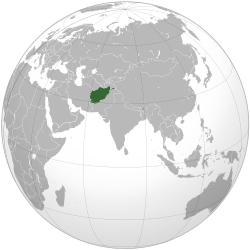Afghanistan In US’ China Containment Strategy – Analysis
By SAAG
By Dr Subhash Kapila
“By and large the Obama Administration has embraced a determined strategy in Afghanistan. Now it should explain the imperative of getting the endgame right. Securing a long-term US & NATO presence in Afghanistan would enable counter-terrorism missions in the region and give Afghanistan’s national security forces enough time to reach a sufficient size and capacity to assume responsibility from the Coalition. The United States would have a platform for dealing with regional consequences, such as a Pakistani state-collapse in which nuclear weapons fall into the hands of extremists”. — Zalmay Khalilzad, Former US Ambassador to Afghanistan.
United States determination to stay military embedded in Afghanistan beyond 2014 stands underscored by two significant developments in May 2012. The first significant development was the signing of the US-Afghanistan Strategic Partnership and the second significant outcome emerged from the NATO Chicago Summit 2012.

The US-Afghanistan Strategic Partnership is a prelude to its eventual crystallization as a bilateral Mutual Security Pact between Afghanistan and the United States. In essence this would ensure a Forward Military Presence of the United States, not by sizeable deployment of US Forces but relying on a network of Air Force Bases, Special Forces deployments and training and military advisory teams. The United States would have the military capacity to build on this framework any sizeable military deployments required to deal with any regional contingencies.
The NATO Chicago Summit in first week of May 2012 asserted and reaffirmed NATOs enduring commitment to Afghanistan beyond 2014. NATO committed continued political and ‘practical’ support to Afghanistan after 2014.
President Obama declared at Chicago that “Today we can agree on NATO’s long term relationship with Afghanistan beyond 2014 including our support of Afghan Security Forces.”
Earlier, the United States President had proposed designation of Afghanistan as a Major Non-NATO Ally.
United States and NATO security commitments to Afghanistan need to be viewed at two levels. In the short-term perspective there is no doubt that the US&NATO planning on Afghanistan is 2014- centric with twin objectives of ensuring a drawback of US forces from Afghanistan and concurrently assisting and ensuring that Afghan National Army starts effectively shouldering combat and security responsibilities.
Viewed at the second level, it is clear that the United States is determined not to create a military vacuum in Afghanistan beyond 2014 which could be exploited by Pakistan and Taliban and as a sequential follow-up by China.
This can be termed as the smaller picture focussed entirely on stabilising Afghanistan, not creating a strategic vacuum with a draw-down of US&NATO Forces and preparing Afghanistan National Army’s in terms of capacity-building with US &NATO continued assistance even beyond 22014 to withstand regional turbulence. But there is a bigger strategic picture that must not be lost sight of.
Analytically, the US-Afghanistan Mutual Security Treaty, NATOs enduring commitment to Afghanistan beyond 2014 and designation of Afghanistan as Major Non-NATO Ally need to be viewed in perspectives beyond the US-Afghanistan-Pakistan triangle.
Strategic analysis would suggest that the United States blue-print on Afghanistan of continued embedment beyond 2014 would suggest a greater design arising from Afghanistan’s geostrategic significance in relation to Central Asia and more significantly in relation to the evolving United States’ China-containment strategy.
Afghanistan’s strategic significance in United States’ China containment strategy does not arise from any long contiguous physical borders with China, which Afghanistan does not have in any case. Afghanistan has a short border with China through the strategic strip of the Wakhan Corridor.
Afghanistan’s strategic significance in United States China-containment strategy primarily arises from the large number of Air Force bases available in Afghanistan and more particularly in Northern Afghanistan. These become critical not only existentially as a strategic pressure point against China but also in the extreme eventuality of a US-China confrontation as a springboard for US Air Force operations against China’s Western peripheries.
While there is a commitment in the Strategic Partnership Agreement that Afghanistan territory would not be used for operations against third countries, two things need to be borne in mind in this connection. Firstly the eventual bilateral Mutual Security Treaty may be modelled on the lines of similar US Treaties with Japan and South Korea which permits US deployments. Secondly, as history would show that when chips are down anything can happen.
Some may like to contend that Afghanistan as a component of United States China-containment strategy is a far- fetched idea as many imponderables exist which may impede continued US&NATO Forces presence in Afghanistan till 2014.
The above can be contested on two grounds. Firstly, it presupposes that Pakistan Army and its affiliates can still make a United States military presence in Afghanistan untenable. Secondly, that the Taliban with Pakistan Army support can still facilitate a Taliban take-over of Kabul.
Contextually, both Pakistan Army and the Taliban have by now overplayed their hands and any impeding of US strategic end-game objectives by them could in the extreme result in a military intervention by the United States against Pakistan. United Sates refusal to apologise on the Salalah incident and continued US drone strikes in Pakistan frontier areas should convince the Pakistan Army that their game s up in Afghanistan.
The two significant developments of May 2012 stated above amply make it clear that the United States is determined to stay militarily embedded in Afghanistan, not because of Pakistan or Iran only.
The United States is determined to stay militarily embedded in Afghanistan as part of a long term strategic blueprint which encompasses exercising strategic influence over Central Asia and the larger strategic aim of US strategy of containment of China.
When viewed through the United States military prism and imperatives of a western pivot for US containment strategy of China and making militarily vulnerable the Pakistan-China strategic corridor from Khunjerab Pass to Gwadur Port in proximity to Hormuz Straits, comprising integrated grid of highways, railway lines, and oil-pipelines, US military embedment in Afghanistan emerges as a prized US strategic aim.
